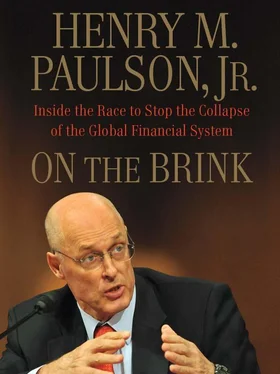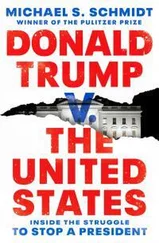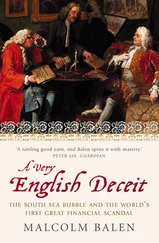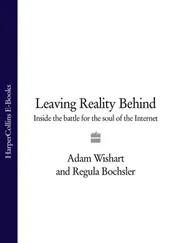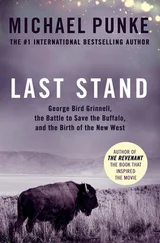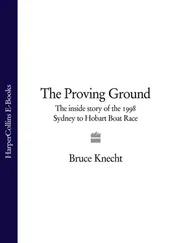I have been blessed with a good memory, so I have almost never needed to take notes. I don’t use e-mail. I rarely take papers to meetings. I frustrated my Treasury staff by seldom using briefing memos. Much of my work was done on the phone, but there is no official record of many of the calls. My phone log has inaccuracies and omissions. To write this book, I called on the memories of many of the people who were with me during these events. Still, given the high degree of stress during this time and the extraordinary number of problems I was juggling in a single day, and often in a single hour, I am sure there are many details I will never recall.
I’m a candid person by nature and I’ve attempted to give the unbridled truth. I call it the way I see it.
In Washington, congressional and executive branch leaders are underappreciated for their work ethic and for the talents they apply to difficult jobs. As a result, this book has many heroes.
I’ve also tried to tell this story so that it could be readily understood by readers of widely varying degrees of financial expertise. That said, I am sure it is overly simplified in some places and too complex in others. Throughout the narrative, I cite changes in stock prices and credit default swap rates, not because those numbers matter in and of themselves, but because they are the most effective way to represent the plummeting confidence and rising sense of crisis in our financial markets and our economy during this period.
I now have heightened respect for anyone who has ever written a book. Even with a great deal of help from others, I have found the process to be most challenging.
There is no question that these were extraordinary and tumultuous times. Here is my story.
Thursday, September 4, 2008
Do they know it’s coming, Hank?” President Bush asked me.
“Mr. President,” I said, “we’re going to move quickly and take them by surprise. The first sound they’ll hear is their heads hitting the floor.”
It was Thursday morning, September 4, 2008, and we were in the Oval Office of the White House discussing the fate of Fannie Mae and Freddie Mac, the troubled housing finance giants. For the good of the country, I had proposed that we seize control of the companies, fire their bosses, and prepare to provide up to $100 billion of capital support for each. If we did not act immediately, Fannie and Freddie would, I feared, take down the financial system, and the global economy, with them.
I’m a straightforward person. I like to be direct with people. But I knew that we had to ambush Fannie and Freddie. We could give them no room to maneuver. We couldn’t very well go to Daniel Mudd at Fannie Mae or Richard Syron at Freddie Mac and say: “Here’s our idea for how to save you. Why don’t we just take you over and throw you out of your jobs, and do it in a way that protects the taxpayer to the disadvantage of your shareholders?” The news would leak, and they’d fight. They’d go to their many powerful friends on Capitol Hill or to the courts, and the resulting delays would cause panic in the markets. We’d trigger the very disaster we were trying to avoid.
I had come alone to the White House from an 8:00 a.m. meeting at Treasury with Ben Bernanke, the chairman of the Federal Reserve Board, who shared my concerns, and Jim Lockhart, head of the Federal Housing Finance Agency (FHFA), the main regulator for Fannie and Freddie. Many of our staffers had been up all night—we had all been putting in 18-hour days during the summer and through the preceding Labor Day holiday weekend—to hammer out the language and documents that would allow us to make the move. We weren’t quite there yet, but it was time to get the president’s official approval. We wanted to place Fannie and Freddie into conservatorship over the weekend and make sure that everything was wrapped up before the Asian markets opened Sunday night.
The mood was somber as I laid out our plans to the president and his top advisers, who included White House chief of staff Josh Bolten; deputy chief of staff Joel Kaplan; Ed Lazear, chairman of the Council of Economic Advisers; Keith Hennessey, director of the National Economic Council (NEC); and Jim Nussle, director of the Office of Management and Budget. The night before, Alaska governor Sarah Palin had electrified the Republican National Convention in St. Paul, Minnesota, with her speech accepting the nomination as the party’s vice presidential candidate, but there was no mention of that in the Oval Office. St. Paul might as well have been on another planet.
The president and his advisers were well informed of the seriousness of the situation. Less than two weeks before, I had gotten on a secure videoconference line in the West Wing to brief the president at his ranch in Crawford, Texas, and explained my thinking. Like him, I am a firm believer in free markets, and I certainly hadn’t come to Washington planning to do anything to inject the government into the private sector. But Fannie and Freddie were congressionally chartered companies that already relied heavily on implicit government support, and in August, along with Bernanke, I’d come to the conclusion that taking them over was the best way to avert a meltdown, keep mortgage financing available, stabilize markets, and protect the taxpayer. The president had agreed.
It is hard to exaggerate how central Fannie and Freddie were to U.S. markets. Between them they owned or guaranteed more than $5 trillion in residential mortgages and mortgage-backed securities—about half of all those in the country. To finance operations, they were among the biggest issuers of debt in the world: a total of about $1.7 trillion for the pair. They were in the markets constantly, borrowing more than $20 billion a week at times.
But investors were losing faith in them—for good reason. Combined, they already had $5.5 billion in net losses for the year to date. Their common share prices had plunged—to $7.32 for Fannie the day before from $66 one year earlier. The previous month, Standard & Poor’s, the rating agency, had twice downgraded the preferred stock of both companies. Investors were shying away from their auctions, raising the cost of their borrowings and making existing debt holders increasingly nervous. By the end of August, neither could raise equity capital from private investors or in the public markets.
Moreover, the financial system was increasingly shaky. Commercial and investment bank stocks were under pressure, and we were nervously monitoring the health of several ailing institutions, including Wachovia Corporation, Washington Mutual, and Lehman Brothers. We had seen what happened in March when Bear Stearns’s counterparties—the other banks and investment houses that lent it money or bought its securities—abruptly turned away. We had survived that, but the collapse of Fannie and Freddie would be catastrophic. Seemingly everyone in the world—little banks, big banks, foreign central banks, money market funds—owned their paper or was a counterparty. Investors would lose tens of billions; foreigners would lose confidence in the U.S. It might cause a run on the dollar.
The president, in suit coat and tie as always, was all business, engaged and focused on our tactics. He leaned forward in his blue-and-yellow-striped armchair. I sat in the armchair to his right; the others were crowded on facing sofas.
I told the president we planned to summon the top management of Fannie and Freddie to meet with Bernanke, Lockhart, and me the following afternoon. We’d lay out our decision and then present it to their boards on Saturday: we would put $100 billion of capital behind each, with hundreds of billions of dollars more available beyond that, and assure both companies of ample credit lines from the government. Obviously we preferred that they voluntarily acquiesce. But if they did not, we would seize them.
Читать дальше
